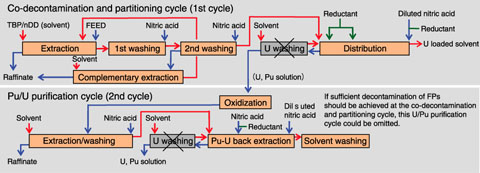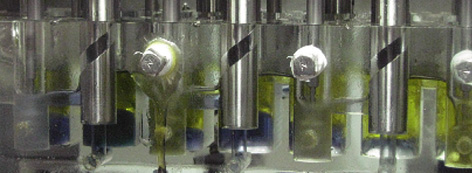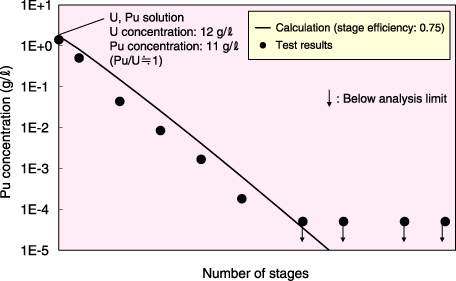
Fig.1-34 Schematic image of co-processing process

Fig.1-35 The situation of Pu stripping in the partitioning unit

Fig.1-36 Pu concentration profile in the partitioning unit (organic phase, Pu/U = 3%)
An investigation of the smooth transition from the current light-water-reactor (LWR) cycle to the fast-breeder-reactor (FBR) cycle was carried out in association with government ministries, electric utilities, plant vendors, and the Japan Atomic Energy Agency (JAEA). One of the important items of the investigation was the appraisal of several reprocessing p rocesses that will be applied after the end of the lifetime o f the Rokkasho Reprocessing Plant. As a result, the co-processing process, which is a modification of the PUREX process for non-isolation of Pu, was selected as the most promising process[1].
The co-processing process was developed through a flowsheet study on process calculation and its verification by miniature mixer-settler tests. In order to secure the i nternationally acceptable proliferation resistance, the flowsheet of the process was set up to prevent the isolation of Pu, even with changes in operational conditions such as reagents and flow rates. Furthermore, if the performance indices (such as decontamination factors (DF) of fission products (FPs)) of the co-decontamination and partitioning cycle were good enough, then the omission of the subsequent Pu/U purification cycle could be viable (Fig.1-34).
The mixer-settler tests focusing on the partitioning unit were carried out using U/Pu nitric solution at the Operation Testing Laboratory (OTL) of the Tokai Reprocessing Plant. The Pu/U ratios of the feed solutions were prepared as 1%, 3%, and 20%; these compositions were adopted considering the composition of future spent fuels from LWR, LWR-MOX, and FBR systems and their mixing treatments. The stripping performance of Pu accompanied by U was good in the cases of Pu/U ratios of 3% and 20% (Fig.1-35 and Fig.1-36). The U/Pu ratios of the product solutions were s uitable for the fabrication of FBR-MOX fuel (0.5<U/Pu<2.0)[2]. Further experiments should be conducted under the condition of a Pu/U feeding ratio of 1% to ensure the applicability of the co-processing process for all future types of fuels.
This work is the result of a study entrusted to the JAEA by the Ministry of Economy, Trade and Industry (METI).
<Previous: 1-12 | Next: 2 Research and Development on Geological Disposal of High-Level Radioactive Waste >